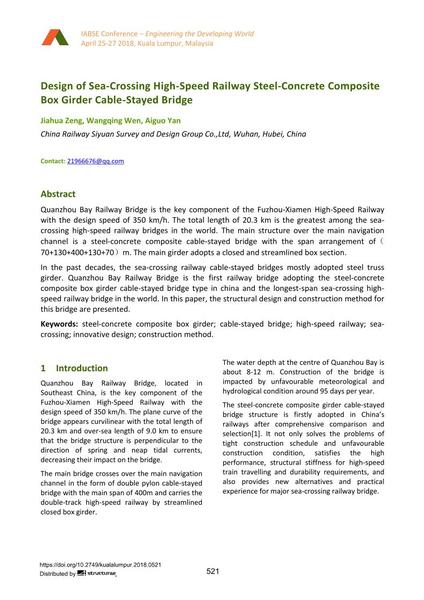Design of Sea-Crossing High-Speed Railway Steel-Concrete Composite Box Girder Cable-Stayed Bridge

|
|
|||||||||||
Bibliografische Angaben
| Autor(en): |
Jiahua Zeng
(China Railway Siyuan Survey and Design Group Co.,Ltd, Wuhan, Hubei, China)
Wangqing Wen (China Railway Siyuan Survey and Design Group Co.,Ltd, Wuhan, Hubei, China) Aiguo Yan (China Railway Siyuan Survey and Design Group Co.,Ltd, Wuhan, Hubei, China) |
||||
|---|---|---|---|---|---|
| Medium: | Tagungsbeitrag | ||||
| Sprache(n): | Englisch | ||||
| Tagung: | IABSE Conference: Engineering the Developing World, Kuala Lumpur, Malaysia, 25-27 April 2018 | ||||
| Veröffentlicht in: | IABSE Conference Kuala Lumpur 2018 | ||||
|
|||||
| Seite(n): | 521-525 | ||||
| Anzahl der Seiten (im PDF): | 5 | ||||
| DOI: | 10.2749/kualalumpur.2018.0521 | ||||
| Abstrakt: |
Quanzhou Bay Railway Bridge is the key component of the Fuzhou-Xiamen High-Speed Railway with the design speed of 350 km/h. The total length of 20.3 km is the greatest among the sea- crossing high-speed railway bridges in the world. The main structure over the main navigation channel is a steel-concrete composite cable-stayed bridge with the span arrangement of( 70+130+400+130+70)m. The main girder adopts a closed and streamlined box section. In the past decades, the sea-crossing railway cable-stayed bridges mostly adopted steel truss girder. Quanzhou Bay Railway Bridge is the first railway bridge adopting the steel-concrete composite box girder cable-stayed bridge type in china and the longest-span sea-crossing high- speed railway bridge in the world. In this paper, the structural design and construction method for this bridge are presented. |
||||
| Stichwörter: |
Schrägseilbrücke Meeresüberquerung Bauverfahren
|
||||



